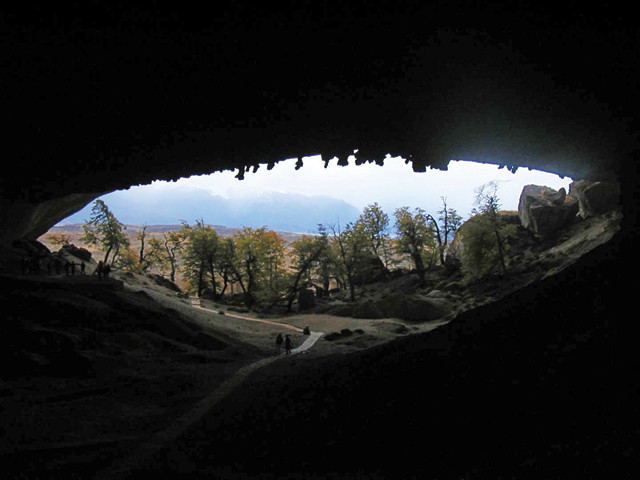
by Mary Caperton Morton Tuesday, September 13, 2016

Cueva del Milodón, or Mylodon Cave, in Patagonia was named after the giant ground sloth whose mummified skin and large deposits of dung were found in the cave. Credit: Alan Cooper.
During the last ice age, giant mammals roamed the wide-open steppes of what is now Patagonia. Around the time that humans were making their way down through North America and into South America, the climate began warming and large species of giant sloths and saber-toothed cats soon disappeared. Now, researchers looking at mitochondrial DNA from some of these megafaunal species are shedding light on the timing of the extinction and whether encroaching humans or changing climate — or both — were to blame for their disappearance.
Patagonia is an ideal place to study the Late Pleistocene megafaunal extinction, says Alan Cooper, a biologist at the Australian Center for Ancient DNA at the University of Adelaide and a co-author of a new study in Science Advances. “Patagonia has a number of volcanic caves and lake shore caves, many of which are stocked with megafaunal remains,” he says. “The cold temperatures also help preserve DNA and make for high-resolution data.”
Cooper and his colleagues used mitochondrial DNA extracted from radiocarbon-dated bones and teeth found in caves across Patagonia and Tierra del Fuego to map the genetic history of six megafaunal species, including the giant jaguar, large ground sloths and the one-ton short-faced bear. “The combination of radiocarbon dating and mitochondrial DNA allowed us to see the timing of the major changes in diversity of these populations,” Cooper says, and to “compare that timing with the arrival of humans in the area, as well as with the timing of warming.”
The team identified a narrow extinction phase starting about 12,300 years ago, while the earliest dates from archaeological sites place humans in the region starting about 14,600 years ago. “Clearly, we have a prolonged overlap between human presence in the area and the megafaunal extinction. These animals were coexisting with humans for some time before [the animals] started disappearing,” Cooper says.
To better understand why the megafauna started dying out, the team turned to previously published Antarctic ice-core records to examine regional climate change at the time. They found that humans arrived right before a cold phase, known as the Antarctic Cold Reversal stadial, which started 14,500 years ago and persisted for two millennia until the next warming phase began about 12,500 years ago. “That 2,000-year window is when we see megafauna and humans coexisting. But as soon as the stadial ends and climate starts warming, within 200 years the megafauna go extinct,” Cooper says. “That’s kind of a smoking gun.”
Previous studies have used radiocarbon dating and climate records to try to pinpoint megafaunal extinctions, but the addition of ancient DNA in this study makes it especially compelling, says Emily Lindsey, a paleoecologist at the University of California, Berkeley, who was not involved in the new study. “Ancient DNA is a really important piece of this puzzle.”
As South America was warming, it was also getting wetter. Pollen records that Lindsey and her colleagues have studied show that tree cover was increasing across the continent, putting pressure on many of the megafaunal species that were adapted to living in grasslands. The new findings add support to the hypothesis that a confluence of human pressures such as hunting and increased fires, combined with the pressure brought about by climate change, likely led to the demise of most of the megafaunal species at the end of the ice age, Lindsey says.
“There are a few scientists out there who still favor the Blitzkrieg hypothesis,” which blames overhunting by humans as the primary driver of megafaunal extinctions, Lindsey says, “but studies like [Cooper et al.’s] are showing that there was longer overlap between humans and megafauna than we initially thought.
© 2008-2021. All rights reserved. Any copying, redistribution or retransmission of any of the contents of this service without the expressed written permission of the American Geosciences Institute is expressly prohibited. Click here for all copyright requests.